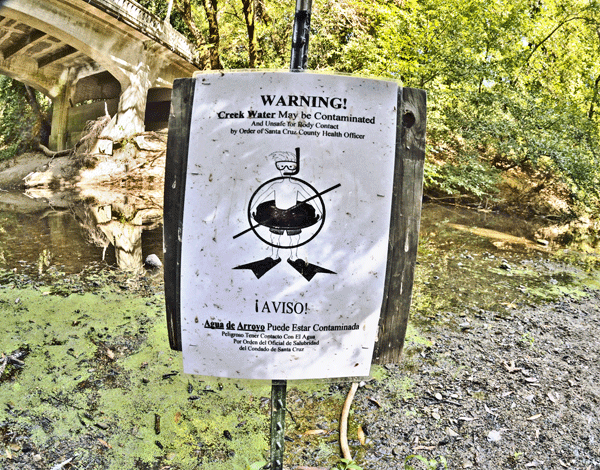
While there are still a few warm days ahead before winter, local residents may find themselves wondering if it’s safe to use San Lorenzo River for water activities.
Just last week, the County of Santa Cruz issued a warning to stay out of the water at the mouth of San Lorenzo River. High levels of Cyanobacteria have been detected at the lagoon, stretching as far the Water Street Bridge. This type of algae can be toxic for pets as well as humans, causing a range of health issues, and even death.
The county’s Water Resources Division Director, John Ricker, said that the algae advisory is localized and does not affect San Lorenzo Valley.
“These are primarily salt and brackish water algae,” he said. “No occurrence of toxic algae has been observed in the river upstream of Santa Cruz.”
Yet, while local residents and their pets are spared from the toxic algae, there are other warnings that have been issued for the San Lorenzo River last week.
Advisories are posted at the Big Trees entrance to Henry Cowell Redwoods State Park due to elevated E. coli levels.
High E. coli levels have also been detected downstream from the tennis courts at Highlands Park.
E. coli bacteria are normally found in the intestines of humans and animals. According to WebMD.com, there is a spectrum of E. coli bacteria types, and most are harmless. However, it’s possible to get sick, and even die, from some of the strains. An infection can take hold when one has ingested tainted water. The bacteria can even spread from one person to another.
While swimming in San Lorenzo River sounds like a risky proposition for this time of year, it’s still allegedly harmless to drink the water provided by the San Lorenzo Valley Water District from the tap.
Jen Michelsen, Environmental Programs Manager for the District, confirmed this information.
“There has been no contamination of drinking water provided by the District,” she said. “The drinking water sources are definitely not affected by the toxic bloom.”
Of course, it’s always up to the individual to decide whether it’s necessary to use additional at home filtration for drinking water.
For more information about the water advisories, visit http://scceh.com/Home/Programs/WaterResources/WaterResourcesDocumentsLinks/CurrentWaterQualityInformation.aspx












